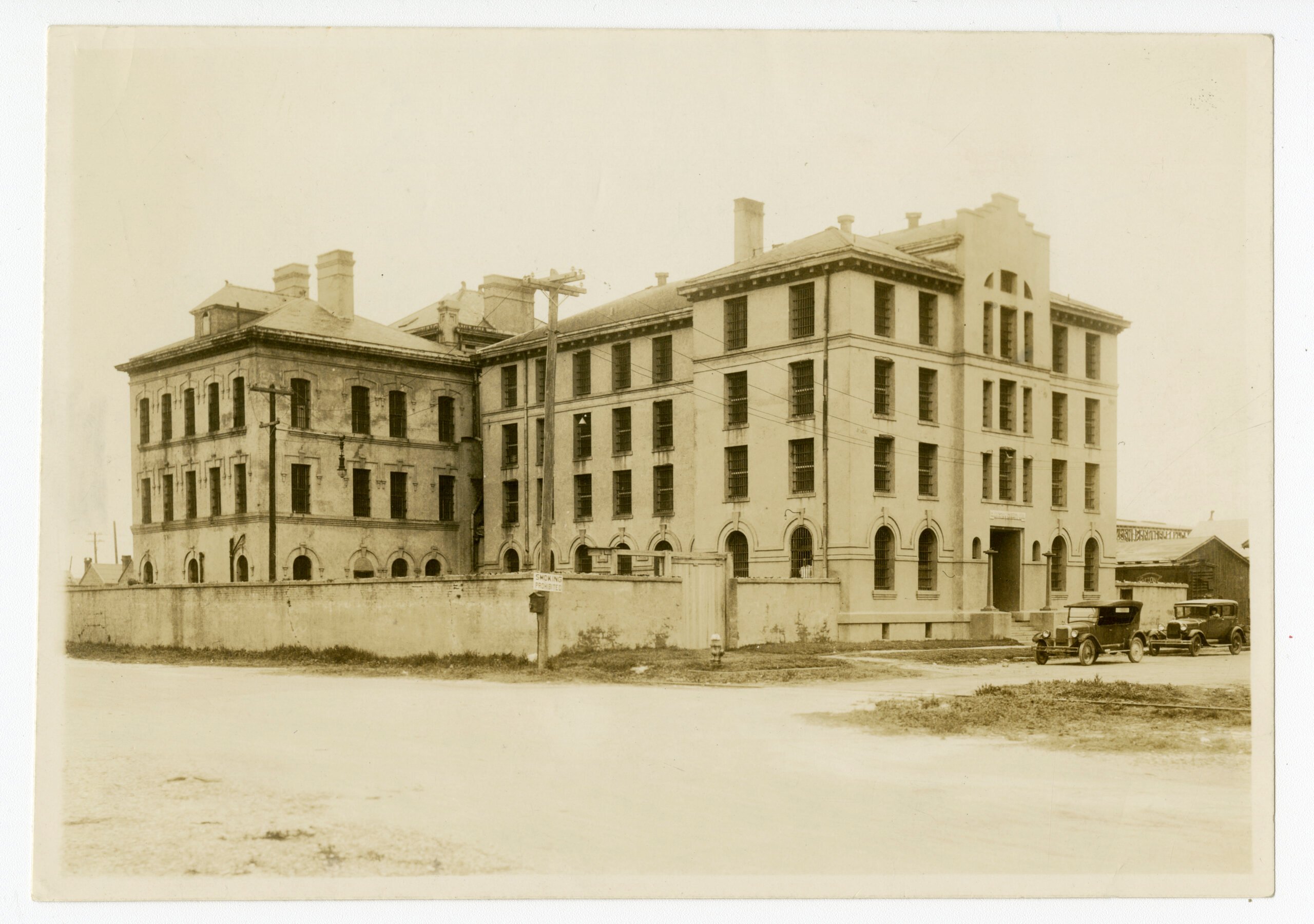Dateline Texas
Kenedy County's Celestial Battle
One of the higher points of land on the Kenedy Ranch, which spans more than 400,000 very flat acres of South Texas coastal plain, is the sand dune where the enterprising Mifflin Kenedy chose to locate his ranch headquarters in the 1880s. On that same lofty spot (38 feet above sea level) his son John Gregory Kenedy later built a Spanish-styled stucco mansion, equipping a lookout tower at the very top with a Gatling gun to ward off invaders. By the 1950s the gun had been dispensed with, but the lookout was still in use: John Gregory’s widowed daughter Sarita Kenedy East would climb up to the tower during the evenings, her whiskey in hand, and survey the miles of mesquite and brush where once she had played cowgirl. To her, even imaginary raids must have seemed long past. Until very recently, the only assaults on this remote stretch of desert south of Corpus Christi were conducted by birdwatchers, solitude-seekers, and northbound immigrants. But invasion once again became a real prospect at the Kenedy Ranch last month, after word got out that military officials and local bureaucrats considered it a good location for the kinds of controversial military exercises conducted currently in Vieques, Puerto Rico.
The “Big House,” as the mansion is called, and 1,100 surrounding acres now comprise the Lebh Shomea house of prayer, a retreat community dedicated to silence and solitude, overseen by the Oblate order of Catholic missionaries. Naturally, it is not the sort of place that wants a Navy-Marine warfare training center for a neighbor. No one speaks at Lebh Shomea (the name means “Listening Heart” in Hebrew), except during morning mass, lunch on Sundays, and scheduled meetings. The rest of the time, the three permanent clerics and their temporary guests hear only the wind, the birds, the crickets and the cicadas–which are sometimes very loud, but not as loud as ship-to-shore shelling. Father Francis Kelly Nemeck, who has served as Lebh Shomea’s director for almost 30 years, says that after some initial experiments with other forms of retreats in the early seventies, which were poorly attended due to the ranch’s out-of-the-way location, he and others realized the facility was best suited to solitary contemplation. Now, Lebh Shomea welcomes up to 25 silence-and-solitude-seekers at a time, who may come from any walk of life and stay for as long as they wish. (Most pay a suggested contribution of $35 per night.)
Nemeck is a lean man in his mid-sixties, quiet but not humorless, who tools around Lebh Shomea in a golf cart and counsels guests in his spartan cedar cabin. As a boy during World War II he lived on a series of military bases, and then in the proximity of military hospitals: His soldier father was severely wounded in the Pacific and spent three years recovering. The family ended up in San Antonio, where Nemeck, who at the age of 13 wanted to be a missionary, entered the Oblate junior seminary. He went on to seminary and graduate work; his doctoral thesis, on the 16th century mystic John of the Cross and 20th century theologian Teilhard de Chardin, addresses “the positive and constructive value of human suffering” and is dedicated to his father. Nemeck came to Lebh Shomea in 1973, after missionary work in South Texas and postings in Texas and Canada.
He learned of the proposed bombing range on June 23, when the news first made the Corpus Christi Caller-Times. As he read that morning, the range would not include Lebh Shomea, but it would occupy 220,000 acres currently owned by two Catholic charities: the Kenedy Memorial Foundation, to which Sarita Kenedy East willed her holdings, and the John G. Kenedy Jr. Charitable Trust, named after East’s brother. (The two entities control all of the ranch except for Lebh Shomea.) It was hard to tell exactly how close the range would be to Lebh Shomea, because, says Nemeck, “Nobody who’s really moving the proposal has had the decency to come here and explain where these borders are. Judging by what’s been printed in the paper we’re within three to five miles of it.”
Just who did know ahead of time about the bombing range isn’t entirely clear. Word of the plan was leaked in conjunction with a bit of Capitol intrigue, starring that intriguer-in-chief, Karl Rove. Rove was reportedly a key player in the administration’s June 14 decision to end the bombing of Vieques in 2003–a decision that caused some Republican hawks to gripe that political adviser Rove was exerting undue influence on military decisions. Then on June 22, The Washington Times reported that Rove had planned to meet with Pentagon officials to be briefed about Vieques, then abruptly cancelled the meeting when questioned about it. Apparently, the possibility of transferring the war games to South Texas would have been part of that briefing.

In subsequent reporting, the following facts came to light: that this ingenious scheme was the brainchild of a retired Marine engineer by the name of Pat Veteto, and that it was further kindled by a representative of that distinguished institute of policy studies, the Kingsville Greater Economic Development Council, as well as by Corpus Christi Congressman Solomon Ortiz (who was publicly critical of the Vieques range) and a “consultant” to the Corpus Christi Chamber of Commerce named Gary Bushell. It was also revealed that an officer of San Antonio’s Frost Bank, which manages the Kenedy Trust, was informed of the proposal almost a year ago. Meanwhile, it seemed that top state officials had not yet been apprised of the details. Asked about the plan on the day of the Times story, Governor Rick Perry asserted there would be no amphibious landing on environmentally sensitive Padre Island, then retracted his statement the next day, after learning he’d been wrong. In Washington, Congressman Ortiz publicly fumed that the plan had been leaked to the media before he and his colleagues had had sufficient time to “build consensus” around the issue.
Nemeck hadn’t heard a thing about the plan. After reading the Caller-Times article, “I was so stunned I just went to prayer for a while. I just sat down in prayer and let it sink in,” he recalls. “Then I notified the sisters, and we started to get phone calls and emails from past guests.” This is not the first time he has confronted a threat of celestial noise. For the past few years, private interests have contemplated building a spaceport on a section of Kenedy Ranch fifteen miles south of Lebh Shomea, for the launching and landing of commercial satellites. The noise and a possible return flight pattern directly over Lebh Shomea are concerns, says Nemeck, who has participated in spaceport planning meetings. “I don’t want to knock the spaceport per se. We have not come out in favor or in opposition of it publicly,” he says. Privately, Nemeck says, he hopes the spaceport is never built, but he recognizes that it might benefit the county economically.
The bombing range proposal, by contrast, represented a much larger and more ominous intrusion, and no one invited Nemeck to any meetings on the subject. Accordingly, his response was quite different. “By nature I’m a very quiet, reserved person who does not like confrontation or argumentation at all,” he says. “And yet I’ve been thrust into this. It’s very difficult, but it’s what I’m being called to at this time.” In less than two weeks, the contemplative priest had learned to do a pretty good imitation of the veteran activist, decrying the potential “rape of the land” for more than one daily newspaper reporter. He repeated the same words to me, referring to the proposal as “utter adulteration and rape of the land, which is truly pristine, the slaughter of the animals. It’s just horrible.”
Once the plan was made public, backers made a hasty effort at further consensus-building; for instance, Bushell and Veteto delivered a power point presentation on the bombing plan to officers of the Sierra Club, arguing that the war games’ environmental impact could be “mitigated.” Unpersuaded, the Sierra Club and a South Texas ecologist continued to voice their concerns to reporters. The longest undeveloped piece of coast in the country would be destroyed, they warned, as would the habitats of various species such as Ridley’s Kemp sea turtle and the piping plover. Destruction of the shrimp beds would jeopardize the entire Gulf Coast shrimping industry. The beach grass cover, once loosed by bombing, would disappear, turning the coast into a desert of shifting sands. Another concern arose from the fact that there are miles of oil and gas pipe beneath the surface of the proposed bombing range. Less remarked upon, but sure to have become an issue if the plan had advanced, is the fact that although Kenedy County has only 414 residents, thousands of Mexican immigrants pass through every year. Twice last year, a border patrol vehicle ran over an immigrant hiding in tall grass on the Kenedy Ranch.
By July 4, the bombing range’s prospects had diminished considerably. The Kenedy County Commissioners’ Court voted against it. Republican Senator Kay Bailey Hutchison, who has done her share of cheerleading for the military, said she doubted she would support the proposal, citing local opposition. Veteto then acknowledged that the plan was unlikely to go forward without Hutchison’s support.
That morning at Lebh Shomea, Nemeck seemed quite pleased by the Caller-Times’ latest story, and was looking forward to a quiet Independence Day. “We won’t have any fireworks,” he said, “and it looks like we won’t have any bombs either.”
A few days later, the Kenedy Memorial Foundation announced its opposition to the bombing range. A Navy-sponsored study concluded that the region south of Corpus Christi compared unfavorably to other possible warfare training locations, due to logistical and environmental issues. Finally on July 11, Navy Secretary Gordon England announced that no bombing range would be located in South Texas, because the site would not be ready by 2003. Congressman Ortiz, having apparently at long last gotten wind of the prevailing sentiment in his district, heralded the decision as “good news.”
And so it is back to solitude and spaceports on the Kenedy Ranch. The Gatling gun may be returned to storage, for now.


